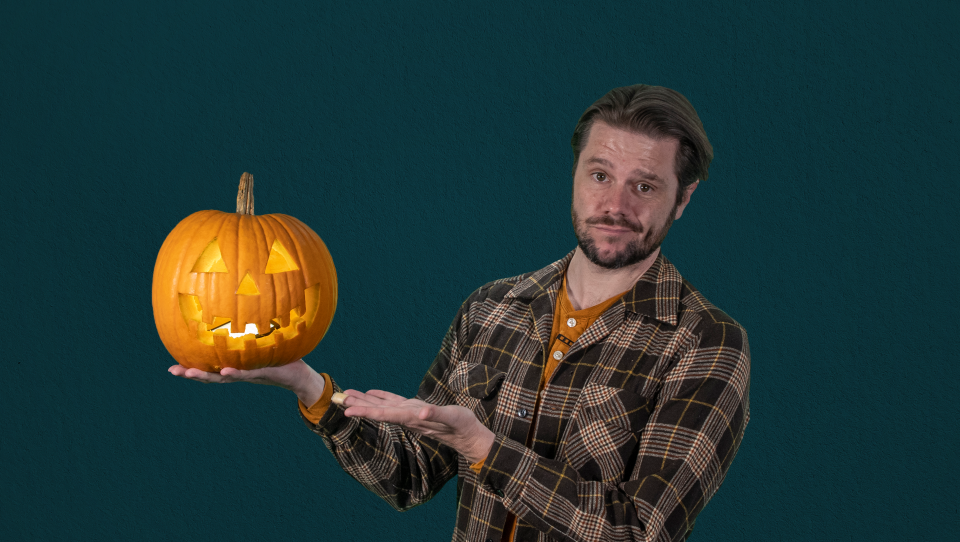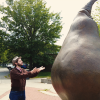If you are going to carve a scary face into a bright orange pumpkin, the first thing you need is a bright orange pumpkin. And the prevalence of this autumn icon is a story a long time in the making.
"It’s got such an old history that goes back pre-colonial for thousands of generations," said chef Sean Sherman, founder of The Sioux Chef and Culinary Director for the Indigenous Food Lab.
Cucurbita pepo — the species that includes what we today distinguish as pumpkins, squash and zucchini — was first domesticated in present-day Mexico, and then spread throughout North America.
"There were so many groups across North America, from Mexico through Alaska. And within each of these regions where there was agriculture, people had innovated and grown all sorts of varietals of squash," said Sherman. "And those particular pieces are celebrated for generations."
Including here in this area. And when European colonists arrived in present-day New England in the 1600s, they too turned to squash and pumpkins.
"The colonists ate pumpkins of all sorts," said University of Delaware professor Cindy Ott, author of Pumpkin: The Curious History of An American Icon. "It’s prolific. It grows like a weed. It stores. It sustains them."
WATCH: Why Do We Carve Pumpkins Into Jack-O'-Lanterns For Halloween?
But in the 1800s, the Connecticut field pumpkin was separated from the C. pepo pack, so to speak.
"More people are moving into cities. The squash kind of goes into these European markets, but the pumpkin — like the big, round, orange Connecticut field pumpkin — that one stays behind on the farm," said Ott.
It stayed behind because, unlike a number of its relatives, it didn’t sell well as a food at market. It was grown mainly for animal fodder on small, rural farms. But it did look great. And even back in the 19th century, it turns out there was a market for nostalgia here in America.
"It's a cultural story that the orange field pumpkin became the pumpkin," said Ott. "It was a part of that old-fashioned way of making a living off the land. In America, we inculcate great values in that, you know, these agrarian ideals and a carrier of these deep meanings. And so it becomes popular to Americans ... because the deep stories that they invested in it."
And so through the 1800s, the pumpkin became an ornamental centerpiece of autumn celebrations, from harvest festivals and county fairs to emerging American holidays like Thanksgiving and Halloween.
"Certainly, there were immigrants from Ireland, Scotland, England who had come over, who were familiar with this kind of holiday and practiced it," said Lesley Bannatyne, author of Halloween: An American Holiday, An American History. "But we reinvented Halloween more or less in America. After the Civil War, Americans were interested in ghosts. They were interested in exotic places like Highland Scotland, and there was a lot of inexpensive media, magazines and newspapers that collected stories about this wonderful, spooky, otherworldly holiday. And Americans loved it."
As for how the pumpkin became the jack-o’-lantern? Bannatyne says a good place to start is with the name.
"Jack-O-Lantern is a name given [to] a light. It appears and disappears. It's combusted gas. It's found over marshes or sometimes at sea," said Bannatyne.
People the world over devised legends to explain this natural phenomenon, including the Irish story of Stingy Jack, who made a fool of the devil and in return was doomed wander the earth for eternity with a lantern. Hence the name Jack O’ Lantern. In Ireland, the tale inspired the practice of carving turnips into lanterns. In New England, it inspired a little rural mischief popular among kids in the 1800s.
"They would steal pumpkins from a field, carve faces in them, light them up, hang them on a stick and float them in front of farmer's windows or pop up from behind walls and scare people," said Bannatyne. "And it was called the jack-o'-lantern trick eventually, because it was something that appeared and disappeared quickly."
And it caught on as a cornerstone of Halloween as the holiday spread throughout America, largely through newspapers, magazines and postcards — sort of the 19th century version of social media.
"So you start to see pumpkins being brought inside as decorations. And they carved faces into some of them to make them more interesting and more spooky, and to give it more atmosphere," said Banntyne. "So, for the first time, the jack-o'-lantern sits still in a party. It doesn't run around and scare people. It's a decoration."
A decoration whose remarkable staying power through the decades could almost be described as supernatural.
If there is something you've been itching to know more about, email The Curiosity Desk or send in your question below. Edgar might just dig up the answer in a future episode. For more from The Curiosity Desk, follow Edgar B. Herwick III on Twitter and subscribe to the GBH News YouTube Channel.







